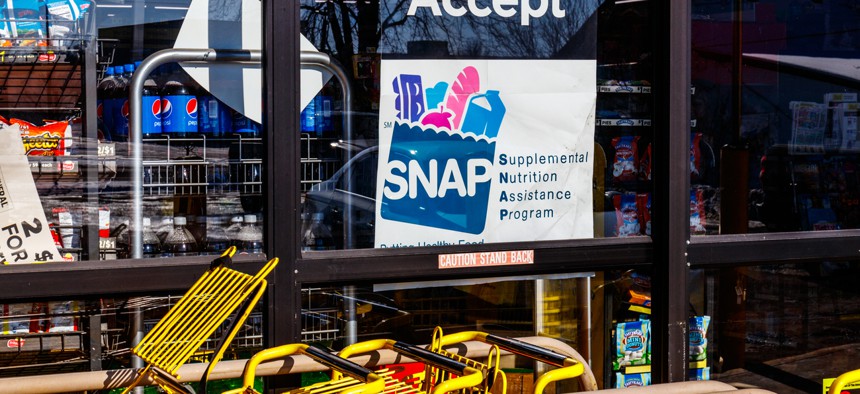Hungry Children Can’t Wait for Government ‘Innovation’
In the midst of a crisis, USDA policies make it nearly impossible for states to deal with the surging need for food assistance.
Two months ago, I wrote in this space about the current pandemic’s potential to serve as a launching pad for innovation in our public assistance programs. At the time, I described a number of arcane policies and processes that were inhibiting the efficient, and much needed, execution of newly authorized emergency support: paper based processes at the Internal Revenue Service; overloaded mental health and substance abuse support lines; antiquated, COBOL-based systems for handling unemployment insurance, and more. My point at that time was that the pandemic offered an opportunity, indeed, a “clarion call,” for innovation.
That remains true. But what is also true, and has become ever more evident, is that those in need are struggling to get the critical support they need now. In short, even as we examine the lessons from the pandemic and evaluate the kind of major programmatic changes and investments that are required, there are steps that need to be taken immediately if we are to ensure that the safety net does what it is intended to do.Nowhere is this more true than in the Supplemental Nutrition Assistance Program, previously known as Food Stamps. In simple terms, because of outdated thinking and policies, millions of American children are almost certainly not getting the SNAP benefits they need. And that isn’t acceptable. And oddly, SNAP stands almost alone in the limitations imposed on it.First, a few facts. Moody’s Analytics projects that SNAP participation (need) will peak at around 70 million as a result of the pandemic. For the sake of comparison, the peak during the last recession was about 50 million. It is now estimated that fully 40% of households with children under 12 are “food insecure,” up from 15% a year ago. CNBC reported that as of mid-May, Florida had only taken action on 28% of the nearly 2 million claims that had been filed in the preceding two months.
Meanwhile, demands on other aspects of the public assistance ecosystem, prominently including unemployment insurance, have also skyrocketed. Yet, although implementation of expanded unemployment benefits has not been without significant challenges, Congress has given state unemployment s flexibilities that are, inexplicably, not available to SNAP program offices. As such, states are far better able to deal with the overwhelming demand they face. Specifically, the CARES Act authorizes states to use contractors and technology, rehire retirees and part-time employees, to deal with the unprecedented surge of applications for unemployment insurance.
Today, the District of Columbia and more than half of the states—evenly split by which party is in control of the governor's mansion—are now capitalizing on this unemployment insurance flexibility. For example, Washington, D.C., brought on contract support to deal with caller wait times that were as long as five hours; that has now been brought down to 30 minutes or less. In North Carolina, the state was logging more than 125,000 calls per day, but existing internal resources could only handle about 10% of them. Since hiring contractors to help manage the volume, the backlog has now been cut in half.
But not SNAP. Agriculture Department policy prohibits similar flexibility for State SNAP program offices. Moreover, the Families First Act expanded eligibility for SNAP but was silent on how states could meet those increases. As a result, it is almost impossible for many states to deliver food support to all children in need. Even worse, USDA recently reiterated that all SNAP applicants may only use paper documents as evidence of eligibility, even though other simpler, more efficient methods are available (e.g., electronic data from federal agencies such as the IRS). This just serves to further exacerbate inefficiencies at a time when timeliness is essential.
Think about that for a moment. We are in the midst of a major national health emergency and attendant economic crisis, and one agency has simply refused to allow states to pursue proven solutions to help deal with the incredible surge requirements they are facing. How does that make sense? How is that fair to children in need?
Let’s also be clear about a couple of things. Contracting-out eligibility verification or similar work can and should be accompanied by clear guardrails so that contract incentives are structured around the speed of delivery of support to those in need, the speed and effectiveness of issue resolution, customer satisfaction, and the accuracy of payments (an area in which SNAP has long needed improvement). In other words, contracts can and should be emblematic of what citizen-service and citizen-centric government is all about.
Second, adding temporary support is not an indictment of the existing workforce; how can a workforce sized for normal times be expected to handle the overwhelming demands of a crisis like this? While bringing contractors on board can open the eyes of state and federal government entities to different, often more efficient and effective methods and processes, the first and foremost goal is to get aid to those who need it, and to do so quickly.The good news is that there is a simple fix. Congress can amend the Families First Act to authorize states to do precisely what Congress has already authorized for unemployment insurance. This is not the time for tired debates about insourcing and outsourcing. Nor is this very complicated. But time is of the essence and Congress needs to act quickly, just as it did on the previous pandemic response bills. This is a time for getting nutrition to children in need quickly, consistently, and in a manner that protects the interests of both beneficiaries and the taxpayers. To do otherwise would be a disgrace.
NEXT STORY: COVID-19 Won’t Change Us Forever




